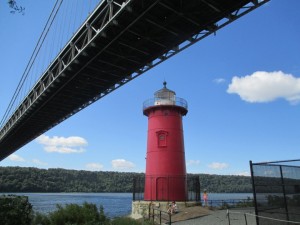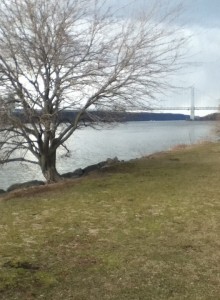As readers of this blog will know, I admire the Great Gray Bridge, aka the George Washington Bridge–finding in it something like my own “beau motif (beautiful motif),” the words Cezanne used to describe Mont Sainte-Victoire, the Provencal peak he made the subject of at least 60 paintings. Not to liken my picture-taking or creativity to the work of the French master, but as I imagine MS-V was for him, the bridge is for me the ideal of an inexhaustible image. Much as my visual appetite thrives on it, I must add that I also admire its fated companion, the Little Red Lighthouse, an image of which from the time I began this blog I placed at the lower right corner on every page of the site. On the right-hand rail of the blog, under the heading “Foundational Posts” is a post I wrote early on called How This Blog Its Name, about these twinned NY landmarks.
If you’ve never had a close-up view of the two structures and aren’t certain where they are or how to see them for yourself, we’re talking about upper Manhattan on the island’s west side roughly level with what would be West 178th Street and the Hudson River. I get there on my bike, pedaling on good pavement along the river most of the way from my neighborhood around West 100th Street. The area can also be reached from Washington Heights, near 181st Street, and in both cases it’s accessible to walkers as well as cyclists. The forty-foot tall lighthouse–whose exterior is dotted with porthole windows and decked out in bright red enameled paint with a white cone and clear glass at the top–sits below the lower deck of the bridge, close to the monumental steel foot of the span’s eastern arch. According to a NYC Parks Dept web page, the two structures became most indelibly linked in the public imagination in the early 1940s, and even earlier in the city’s maritime history. Here’s a lightly edited version of the Parks Dept. article:
Here’s a lightly edited version of the Parks Dept. article:
“In the early 20th century, barge captains carrying goods up and down the Hudson demanded a brighter beacon. The [lighthouse] had been erected on Sandy Hook, New Jersey in 1880, where it used a 1,000 pound fog signal and flashing red light to guide ships through the night. It became obsolete and was dismantled [but not destroyed or discarded] in 1917. In 1921, the U.S. Coast Guard reconstructed this lighthouse on Jeffrey’s Hook [future site of the George Washington Bridge] in an attempt to improve navigational aids on the Hudson River. Run by a part-time keeper and furnished with a battery-powered lamp and a fog bell, the lighthouse, then known as Jeffrey’s Hook Lighthouse [the name since the early 1800s for the shelf of Manhattan schist that juts out in to the river right there], was an important guide to river travelers for ten years. The George Washington Bridge opened in 1931, and the brighter lights of the bridge again made the lighthouse obsolete. In 1948, the Coast Guard decommissioned the lighthouse, and its lamp was extinguished.
“The Coast Guard planned to auction off the lighthouse, but an outpouring of support for the beacon helped save it. The outcry from the public was prompted by the children’s book, The Little Red Lighthouse and the Great Gray Bridge, written by Hildegarde Swift and Lynd Ward in 1942. In the popular book, the Little Red Lighthouse is happy and content until a great bridge is built over it. In the end, the lighthouse learns that it still has an important job to do and that there is still a place in the world for an old lighthouse. The classic tale captured the imaginations of children and adults, many of whom wrote letters and sent money to help save the icon from the auction block.”
The Parks’ web page adds that in 1951 the Coast Guard gave the lighthouse and grounds to the City, and in 1979 the Little Red Lighthouse was officially added to the National Register of Historic Places. Refurbishments took place in 1986, when on the 65th anniversary the concrete foundation was restored, and in 2000 when it was repainted, true to its original shade of red.
In a real sense, the persistence of the lighthouse on the Manhattan shoreline is a product of one of the first episodes of “historic preservation” in the modern history of New York City. Too often, the city and posterity have been the loser in those battles, such as what ocurred in 1963, when–unaccountably to current-day New Yorkers–the old Penn Station was torn down. More recently, fixtures of the city’s industrial and maritime past other than the Little Red Lighthouse have been preserved, such as the old railroad car transfer at 60th Street and the Hudson, which I wrote about and photographed just a couple of days ago.
With all this as prologue, imagine my surprise yesterday when, on one of my bike rides up the Hudson to the bridge, on what turned out to be one of the most stupendously gorgeous days so far this summer, I suddenly spied people walking in and out of the lighthouse doorway–something I had never seen before! Seeing my surprise, a New York City Parks employee explained that in the warmer months, on the second Saturday of each month, they open the lighthouse to visitors. As I let down the kickstand on my old Trek and prepared to enter this maritime abode for the first time, another ranger in uniform greeted me and showed me and a second visitor a burnished brass key that she explained was for a long time used to open the lighthouse’s door. It was a chunky thing with big notches and looked like it weighed nearly a pound. In my eagerness, I neglected to take a picture of it, though I hope to do that the next time I visit, perhaps next month. Entering through the oval-topped door I found a nearly-dark chamber that looked like the lower decks of a ship or a submarine, with panels of thick riveted steel plates making up the walls. As I hope the pictures below help to show, the visitor encounters three spiral staircases with sturdy metal treads underfoot and a curved railing to help you climb up them. Between each flight of stairs, you can peer out the portholes that look south, toward lower Manhattan and Jersey City, and north, up-river toward Yonkers and the upper reaches of Palisade Park in New Jersey. Now, I’ll leave the rest of the storytelling to the photos I took and the captions I write for them. I invite you to visit the little red lighthouse and the great gray bridge for yourself. They are vibrant links to our not so-remote industrial and maritime past. Please click here to see the full photo gallery.
 Readers of this blog may recall when about a month ago I wrote a post after I discovered one day that the NYC Parks Dept opens the Little Red Lighthouse to visitors the second Saturday of each month from May-October. The LRL is the last lighthouse sited in Manhattan, and a unique urban landmark. It sits under the George Washington Bridge, aka known as the Great Gray Bridge, about even with 178th Street on one of the most westerly points in Manhattan. I had a fabulous time that day, exhilarated by the climb up the three steep steel stairways to the lighthouse’s cupola, where you stand out in the open air, viewing a 360-degree circuit from about 45 feet up in the air. That day I was able to take some great pictures: the shadows cast by the great gray bridge on the Hudson River; shoot south toward points in lower Manhattan; and point my camera in the upstate direction toward Yonkers and well past, fantasizing that the Catskills were just beyond a gradual dogleg in the river’s northward push. When I look that direction I imagine Hendrik Hudson in the Half Moon sailing up-river in the multiple voyages he made between 1709-1712.
Readers of this blog may recall when about a month ago I wrote a post after I discovered one day that the NYC Parks Dept opens the Little Red Lighthouse to visitors the second Saturday of each month from May-October. The LRL is the last lighthouse sited in Manhattan, and a unique urban landmark. It sits under the George Washington Bridge, aka known as the Great Gray Bridge, about even with 178th Street on one of the most westerly points in Manhattan. I had a fabulous time that day, exhilarated by the climb up the three steep steel stairways to the lighthouse’s cupola, where you stand out in the open air, viewing a 360-degree circuit from about 45 feet up in the air. That day I was able to take some great pictures: the shadows cast by the great gray bridge on the Hudson River; shoot south toward points in lower Manhattan; and point my camera in the upstate direction toward Yonkers and well past, fantasizing that the Catskills were just beyond a gradual dogleg in the river’s northward push. When I look that direction I imagine Hendrik Hudson in the Half Moon sailing up-river in the multiple voyages he made between 1709-1712.









